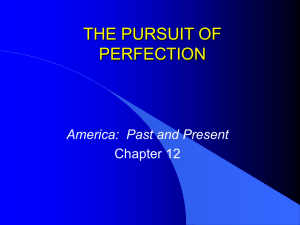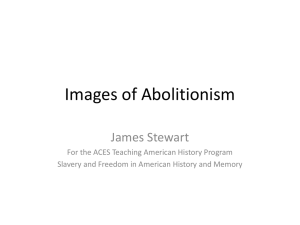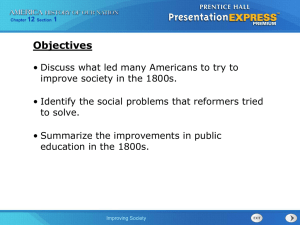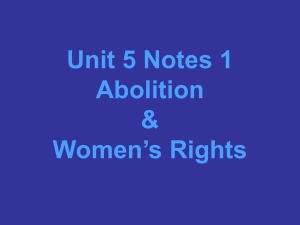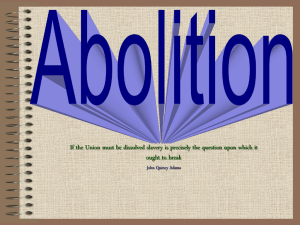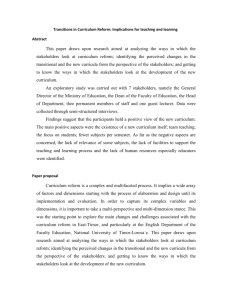Chapter 12 Summary
advertisement
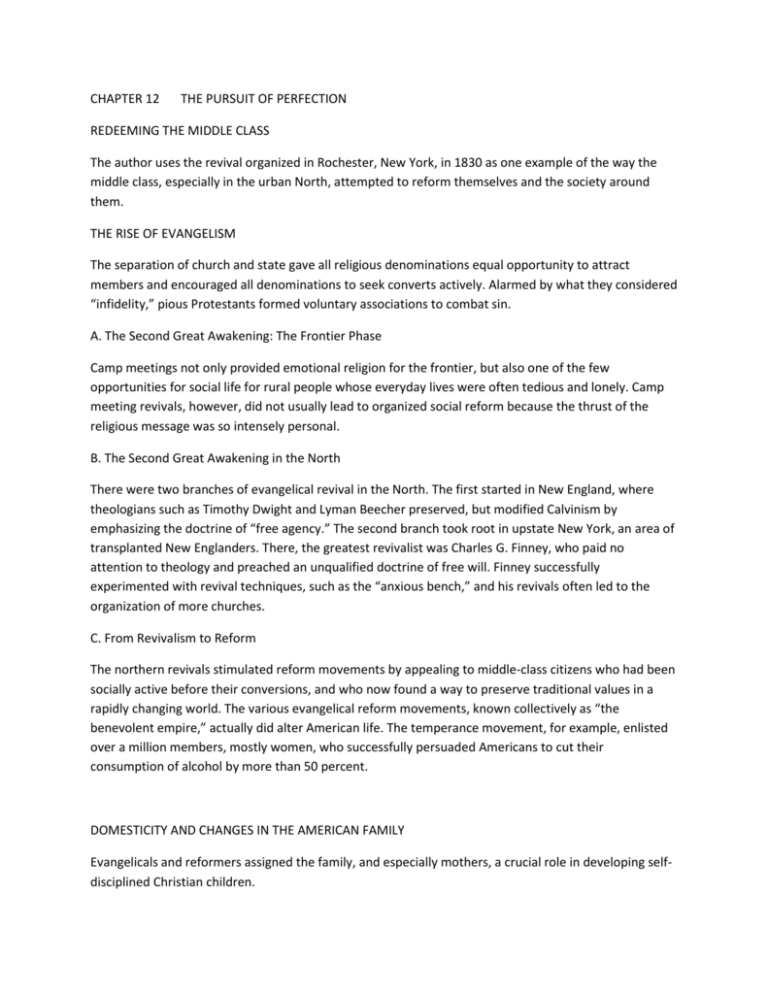
CHAPTER 12 THE PURSUIT OF PERFECTION REDEEMING THE MIDDLE CLASS The author uses the revival organized in Rochester, New York, in 1830 as one example of the way the middle class, especially in the urban North, attempted to reform themselves and the society around them. THE RISE OF EVANGELISM The separation of church and state gave all religious denominations equal opportunity to attract members and encouraged all denominations to seek converts actively. Alarmed by what they considered “infidelity,” pious Protestants formed voluntary associations to combat sin. A. The Second Great Awakening: The Frontier Phase Camp meetings not only provided emotional religion for the frontier, but also one of the few opportunities for social life for rural people whose everyday lives were often tedious and lonely. Camp meeting revivals, however, did not usually lead to organized social reform because the thrust of the religious message was so intensely personal. B. The Second Great Awakening in the North There were two branches of evangelical revival in the North. The first started in New England, where theologians such as Timothy Dwight and Lyman Beecher preserved, but modified Calvinism by emphasizing the doctrine of “free agency.” The second branch took root in upstate New York, an area of transplanted New Englanders. There, the greatest revivalist was Charles G. Finney, who paid no attention to theology and preached an unqualified doctrine of free will. Finney successfully experimented with revival techniques, such as the “anxious bench,” and his revivals often led to the organization of more churches. C. From Revivalism to Reform The northern revivals stimulated reform movements by appealing to middle-class citizens who had been socially active before their conversions, and who now found a way to preserve traditional values in a rapidly changing world. The various evangelical reform movements, known collectively as “the benevolent empire,” actually did alter American life. The temperance movement, for example, enlisted over a million members, mostly women, who successfully persuaded Americans to cut their consumption of alcohol by more than 50 percent. DOMESTICITY AND CHANGES IN THE AMERICAN FAMILY Evangelicals and reformers assigned the family, and especially mothers, a crucial role in developing selfdisciplined Christian children. A. Marriage for Love By the nineteenth century, marriage had changed profoundly. Upper and middle class women expected to marry for love, more forcefully demanded an end to the sexual double standard, were less deferential to their husbands, and more willing to express their love in private correspondence and public display. B. The Cult of Domesticity “The Cult of True Womanhood” placed women in the home, but the home was glorified as the center of all efforts to civilize and Christianize society. Most women who were married to farmers or laborers still contributed to family income, but more and more middle- and upper-class women could afford to dedicate themselves to the home, making it a sanctuary from the outside world. Many women who found themselves liberated from the drudgery of farm chores used their leisure to improve themselves, to get to know other women, and to lead crusades against vice; above all, however, they attempted to become ideal mothers. C. The Discovery of Childhood In the nineteenth century, the child was placed at the center of family life. Each child was looked upon as unique and irreplaceable. Ideal parents no longer “broke” a child’s will; they formed his character with affection. Parental discipline was meant to instill guilt rather than fear, so that the child would eventually learn self-discipline. INSTITUTIONAL REFORM Reformers hoped that public institutions such as schools would continue what the family had begun, or that institutions such as asylums and prisons would mend what the family had failed to do. A. The Extension of Education Between 1820 and 1850, public school systems expanded rapidly, especially in the North. Originally demanded by the working class as a means for advancement, the public schools were seized by middleclass reformers, who saw them as the ideal instrument for inculcating values of hard work and responsibility. Horace Mann overcame the objections of taxpayers who resented having to subsidize the education of the poor by pointing out that public schools would save children of the poor and immigrants from becoming like their parents, vile and troublesome, and a public expense. Many parents, especially Catholics, resented public schools, believing they alienated children from their parents. B. Discovering the Asylum For those who lacked self-discipline, the poor, the criminal, and the insane, reformers hoped harsh measures would lead to rehabilitation. Prisoners, for example, were put into solitary confinement and had to conform to a strict daily schedule at such “model” prisons as the one at Auburn, New York. Rehabilitation, however, seemed not to work. Public support was always skimpy, and most prisons, asylums, and poorhouses became warehouses for the unwanted, who lived in abysmal conditions despite the heroic efforts of Dorothea Dix, who worked tirelessly to bring some decency to these institutions. REFORM TURNS RADICAL Most reformers wanted to improve society, but some of the more radical wanted to destroy society as it existed and create a new, perfect social order. A. Divisions in the Benevolent Empire By the 1830s, radical perfectionists had become impatient with moderate reform and began to form their own societies. The temperance and peace movements split into moderate and radical wings, but the split among the opponents of slavery had more important consequences. Moderate abolitionists hoped for a gradual end to slavery, which they saw as the only realistic possibility, and they even supported removal of blacks from the United States as a concession to white racism. Radical abolitionists, like William Lloyd Garrison, demanded immediate emancipation and formed the American Anti-Slavery Society in 1833. B. The Abolitionist Enterprise Abolitionists grew from the evangelical tradition and drew strength from it. A good example is Theodore Dwight Weld, an itinerant minister who had been converted by Finney. When he became an abolitionist, Weld simply adapted his revivalist techniques to a new cause. Weld was extremely successful in northern Ohio and western New York, where he held mass meetings. The abolitionists appealed mainly to ambitious and hard-working inhabitants of small towns, but often encountered opposition from the working class, who disliked blacks and feared their economic and social competition, and from solid citizens, who regarded abolitionists as anarchists. Abolitionists tended to weaken their influence by perpetual in-fighting. Garrison disrupted the movement by associating it with other radical reforms such as pacifism and feminism. White Southerners, ironically, helped the abolitionists by trying to suppress the right of petition and by censoring the mails to prevent abolitionist literature from being circulated. These attempts backfired. The abolitionist movement succeeded in making slavery a matter of public concern, despite opposition from without and divisions from within. C. Black Abolitionists African Americas always made up the majority of abolitionists, but black abolitionists had to struggle to achieve leadership positions within abolitionist societies. Some, most notably William Douglass and Sojourner Truth, became nationally known, and in 1830 the Negro Convention gave blacks an independent organization. African Americans also published their own abolitionist newspapers, and were the most important figures in running the “underground railroad.” D. From Abolitionism to Women’s Rights The abolitionist movement gave many women an opportunity to engage in a public reform program. In advocating freedom for blacks, women began to realize their own inequality. When they discovered that many male abolitionists refused to accept women as equal partners in protest, women led by Lucretia Mott and Elizabeth Cady Stanton organized the Seneca Falls Convention in 1848, which was the beginning of the movement for female rights. E. Radical Ideas and Experiments In addition to the reform movements inspired by evangelical piety, other attempts were made to create perfect individuals or a perfect society. For example, a number of utopian communities were established, such as the Oneida Community or Brook Farm, but most were short-lived. Intellectuals, repelled by the crudities of the revivalists, sought intense religious experience in a literary and philosophical movement called transcendentalism. Finally, weird reform movements, such as phrenology, spiritualism, and diet fads, promised perfect health or instant self-knowledge. CONCLUSION: COUNTERPOINT ON REFORM Perceptive critics, like Nathaniel Hawthorne, regarded the nation’s pursuit of perfection with a skeptical eye, but the reform impulse, no matter how eccentric at times, opened the way to necessary changes in American life.
